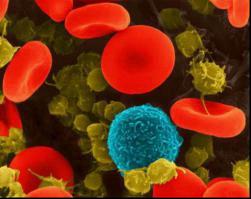
The Cardiovascular system and the components of Blood
Blood is an incredibly complex fluid that uses the network of blood vessels to take the essential supplies such as oxygen and nutrients around the body that we need every day.
Blood is one of the constituents of our bodies that we tend to take for granted. Unless we suffer a catastrophic accident, resulting in major injuries most of us just need a plaster from time to time to patch ourselves up. However, blood is alive with an amazing group of components, completing several vital roles every second of every day, to ensure that we survive.
If our blood is not healthy we can suffer from anaemia, inefficient immune systems, slow healing and frequent infections. Long term blood disorders lead to much more serious illnesses such as cancer and organ failure.
Without a microscope we are unable to see the enormity of the life that is contained in just one small drop of blood. Once you understand some of the properties and duties of your blood and appreciate how vital it is to maintain its integrity, it will be easy to make sure that you include foods in your diet that promote its health and therefore your own.

The Cardiovascular System
Our heart’s function is to pump blood around the body. If this process stops for more than a few seconds we will lose consciousness. Every part of our body requires oxygen and nutrients on demand, including additional supplies when we are under pressure. Our cardiovascular system deals with this process without any thought or involvement from us and in addition it will remove any waste products from our systems at the same time. A healthy cardiovascular system is essential and the quality of our blood is vital to our survival.

Image by VSRao from Pixabay
The circulatory system is made up of arteries, veins and capillaries. The arteries carry the oxygenated blood from the lungs into smaller arterioles, which connect to the veins via capillaries. Unlike the muscle-walled arteries, veins have thin, flexible walls that can expand to hold large volumes of blood. De-oxygenated blood returning to the heart in the veins is at a lower pressure than in the arteries and movement is assisted by a succession of one-way valves that prevent blood from flowing backwards.
The links between the arteries and the veins are the capillaries, which are tiny blood vessels with permeable walls, which allow the exchange of nutrients, oxygen and waste between blood and tissue cells.
Blood is a liquid tissue and your body contains around 8 to 12 pints depending on your age and if you are male or female. Without blood you would die. It performs a number of crucial functions within the body, including the transportation of oxygen and carbon dioxide, food molecules (glucose, fats and amino acids), ions, waste (such as urea), hormones and heat around the body. One of its major functions is the defence of the body against infections and other ingested toxins.
The components of Blood
Within blood is plasma, which is the pale yellow liquid that can easily be replaced by your body when it needs to. It is mainly water and proteins which assist your body in controlling bleeding and fighting infection. It is essential for the circulation of our red and white blood cells and platelets and also ensures that our natural, chemical communication system is operational. This communication system reaches every part of the body via the capillaries and is fuelled by minerals, vitamins, hormones and antibodies.
What are the different blood cell types?
White blood cells are called leukocytes and there are five types carrying out specific roles within the blood. Neutrophils, Eosinophils, Lymphocytes, Monocytes and Basophils.

Neutrophils are the most abundant of the white blood cells and are the first line of defence. They squeeze through the capillaries to infected areas in the body and consume and destroy invading bacteria and viruses. Even when we are healthy this process is essential as we are constantly ingesting, absorbing or inhaling harmful substances in our everyday environment. If our blood is healthy and well-populated with neutrophils we can prevent these invasions leading to illness and disease.
Eosinophils are not very abundant in the blood but they are on stand-by and can increase their numbers dramatically if the body comes under attack from certain types of parasites. The cell will rush to the infected area such as the intestines and release a toxic substance over the parasite to destroy it.
Red blood cells, or erythrocytes, are the most numerous type of blood cell. They are shaped specifically to ensure that they absorb as much oxygen from the lungs as possible. In just one minute 120 million of your red blood cells will die but in the same time frame exactly the same amount will be replaced from the bone marrow. The process actually starts in the kidneys, which release a hormone called erythropoietin, which travels to the bone marrow where it stimulates the production of erythrocytes. This is another reason why it is so vital to maintain the function of your kidneys with a natural, cook from scratch approach to your diet.
Other Cells in the blood.
- B-Lymphocytes (B Cells) are responsible for making our antibodies in response to an infection.
- T-Lymphocytes (T-Cells) are a family of cells including Inflammatory T-cells that rally Neutrophils and macrophages to the site of an infection quickly where they will consume bacteria.
- Cytotoxic T-Lymphocytes that kill virus infected and possibly cancerous tumour cells.
- Helper T-Cells that enhance the production of antibodies.
- Monocytes leave the blood and become macrophages, which are large cells that ingest and destroy any invading antigens that enter the body and also any dead and dying cells from the body.
- Basophils also increase production during an infection and will leave the blood stream via the capillaries and collect at the site of an infection where they will discharge granules that will stimulate the release of histamine, serotonin, prostaglandins and leukotrines. This increases the flow of blood to the infected site and results in an inflammatory reaction. An example of this might be a wasp sting or an allergic reaction to ingesting pollen resulting in a hay-fever attack.
What else is in the blood that is so vital for our health?
Without blood we die and we need a system in place that ensures that any break in the circulatory system is plugged and repaired as quickly as possible.
Platelets are fragments of cells and must be kept at sufficient density in the blood to ensure that when blood vessels are cut or damaged the loss of blood can be stopped before shock and possible death occurs. This is accomplished by a process called coagulation or clotting.
A clot is formed when platelets form a plug, which is enmeshed in a network of insoluble fibrin molecules. This forms over any break in the circulatory system preventing any further loss of blood.
I have covered in earlier posts the absolute necessity of oxygen to our survival. It is unlikely that you will survive longer than six minutes without breathing in oxygen, but it is also vitally important for the survival of every cell within the body. If an area of the cardiovascular system is damaged and oxygen is unable to reach the tissues directly affected then that tissue will die and the infection generated will compromise the health of the rest of the body. The most vulnerable parts of the body are the hands and feet where irreparable damage to the tiny network of capillaries could lead to amputation.
The oxygen carriers.
The red blood cells are responsible for the transportation of both oxygen and carbon dioxide within the haemoglobin in the blood.
As important as breathing in and utilising oxygen is concerned, getting rid of the carbon dioxide waste, which is produced during this process, is equally important. Some carbon dioxide produced in the tissues is processed and converted to a harmless substance that can be eliminated easily but some has to be transported via the blood stream back to the lungs to be got rid of.
Other transportation duties
Substances in the bloodstream like cholesterol and other fats are transported around the body, from originating organs like the liver, to elimination points where they are removed from the blood and either absorbed into cells or processing points such as the kidneys. This process is used to transport glucose and sugars, hormones and waste products like urea that becomes urine.
We are an extremely efficient waste producer and it is when this waste is not eliminated safely, and regularly, from the body that we become ill and diseased.
There are a number of blood disorders that cause concern and one of the most common is Anaemia so I am going to focus on that in the next post – and then follow that up with the foods and therefore the nutrients we require to support healthy blood.
©Sally Cronin Just Food for Health 1998 – 2023

I am a qualified nutritional therapist with twenty-four years experience working with clients in Ireland and the UK as well as being a health consultant on radio in Spain. Although I write a lot of fiction, I actually wrote my first two books on health, the first one, Size Matters, a weight loss programme 20 years ago, based on my own weight loss of 154lbs. My first clinic was in Ireland, the Cronin Diet Advisory Centre and my second book, Just Food for Health was written as my client’s workbook. Since then I have written a men’s health manual, and anti-aging programme, articles for magazines, radio programmes and posts here on Smorgasbord.
If you would like to browse my health books and fiction you can find them here::Sally’s books and reviews
Thanks for visiting and I am always delighted to receive your feedback.. stay safe Sally.




